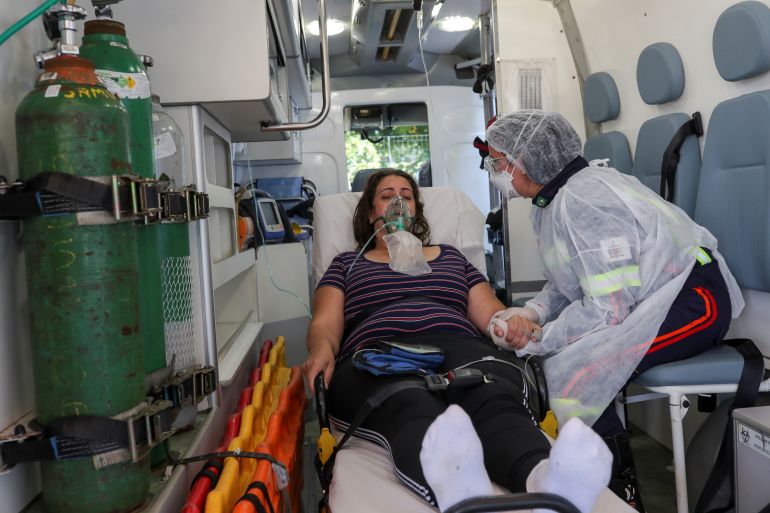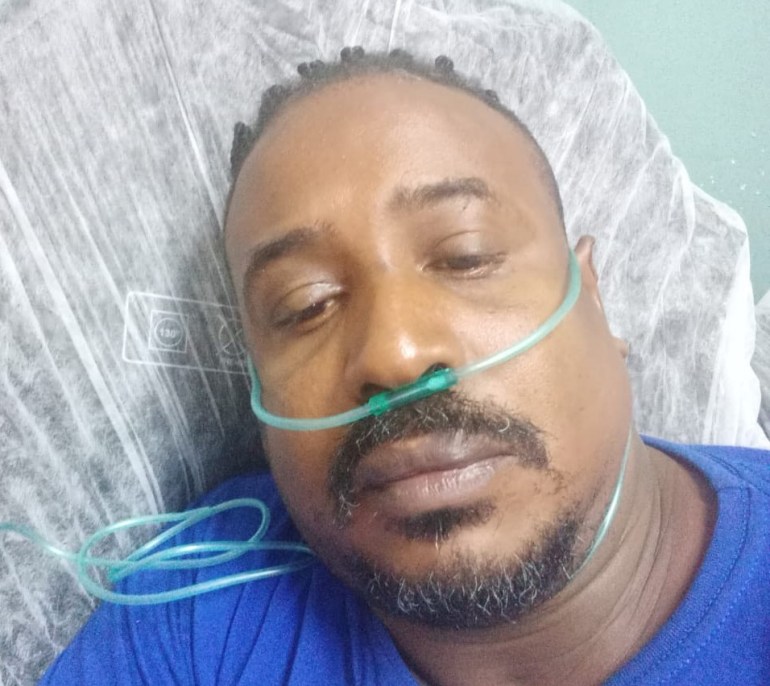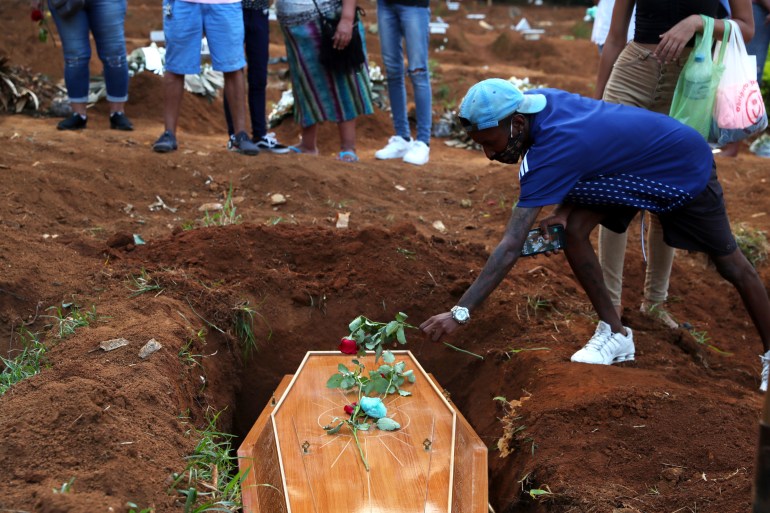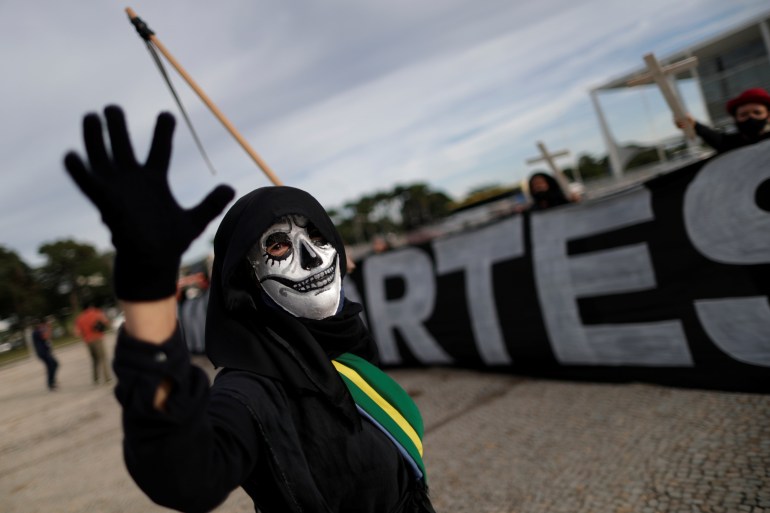‘A miracle I survived’: Younger Brazilians hit by COVID surge
Experts say younger patients are developing severe COVID-19 symptoms and dying, as hospitals are pushed to the brink.

Rio de Janeiro, Brazil – When Allessandro Cabral began to experience COVID symptoms in early March, he thought nothing much of it. In fact, the 41-year-old even reassured his friends: “I have COVID,” he wrote them in a WhatsApp message from his home in Rio de Janeiro’s North Zone. “But I’m not at risk: I eat healthy, I work out. It will pass.”
After a week of light COVID symptoms, however, Cabral’s condition worsened dramatically. He couldn’t breathe and went to a local hospital, then to a field hospital, where he was put on oxygen and was on the verge of being intubated.
Keep reading
list of 4 itemsBolsonaro under pressure as Brazil COVID deaths top 300,000
Brazil sets new COVID deaths record as health minister sworn in
Brazil’s COVID deaths ‘biggest genocide in our history’: Lula
“But God didn’t allow it,” he told Al Jazeera. “I felt sensations of death, it’s a miracle I survived. I wouldn’t even wish that on my worst enemy.”
As he began to improve after 12 days battling the virus, he was startled – not just that he had been at risk, but by the many other patients in their 20s, 30s and 40s also on respirators in his ward.
As Brazil grapples with its deadliest peak of the pandemic yet, with a series of grim records for coronavirus-related deaths and infections, health officials have reported an alarming shift: since the new year, more young patients are developing severe COVID symptoms and dying.

According to data collected by the Brazilian Association of Intensive Care Medicine (Amib) across 1,593 public and private intensive care units, the number of Brazilians aged 18 to 45 requiring intensive care for COVID-19 has tripled between the first wave from September to November 2020 and second wave from February to March 2021.
The data also showed a staggering 193 percent increase in coronavirus-related deaths for this age group, increasing from 13.1 percent to 38.5 percent during the same period.
Younger patients
In a report on Friday, Brazilian public health institute Fiocruz also found that the country’s COVID epidemic is getting younger.
The report said new infections among those aged 39 and 59 jumped by almost 316 percent from the beginning of the year to mid-March, while deaths in that age group also increased by 317 percent in the same period.
“Last year, we had more critical elderly patients. Now, it’s completely distinct. We’re dealing with a substantial number of severe patients in their 30s to 50s,” Dr Anne Menezes from Getulio Vargas Hospital in the jungle city of Manaus, told Al Jazeera.
The 29-year-old said seeing younger patients die is particularly devastating. “We’ve recently lost patients my age. It could have been me. We fought hard to save them, but there comes a point when you have to stop,” she said.
Menezes said that since January, when Manaus’ health system collapsed, the virus has behaved much more aggressively, making it difficult for doctors to predict which patients will develop severe cases and which will not.
“When we have patients with the same profile, we don’t know what their path will be. We had two patients recently, both in their early 40s and obese – a common Brazilian profile – with different outcomes,” she explained.
“The 44-year-old had classic symptoms at first but the virus evolved quickly and we lost her. But the 41-year-old with the same profile survived.”
Several hypotheses
While the exact reason for the surge in new infections and deaths among younger Brazilians is unclear, health experts have pointed to some possible related factors.
First, the trend has coincided with the emergence of at least one new COVID variant. The so-called “P.1 variant”, which first appeared in the Brazilian city of Manaus at the end of 2020, is likely a factor, said Fiocruz epidemiologist Jesem Orellana, from Amazonas state.
The variant is widely agreed to be more infectious and transmissible – by as much as 2.2 times – and 25 to 61 percent more capable of re-infecting people who had been infected with an earlier strain of the virus, according to recent studies conducted by researchers at the University of Sao Paulo in collaboration with Oxford University and Imperial College London.
According to a March 4 Fiocruz study, more than half of all COVID infections in six Brazilian states were “associated with variants of concern”, including P.1, as well as the UK and South African strains.
“It’s very possible that these new strains are more deadly. But we don’t yet have adequate scientific data to confirm,” Orellana told Al Jazeera.

In Manaus, the P.1 variant was found to be most prevalent at approximately 91 percent during the peak of its first wave from 1-13 January this year, according to Fiocruz.
Orellana found that the number of infections among Brazilians aged 40 to 50 in Manaus had increased by 9 percent during the second wave, compared with the first. Orellana’s analysis also found a 12 percent decrease in the number of infections in people over 60.
Other public health experts have pointed to the refusal of some members of the public to abide by coronavirus-related measures – especially during holidays – and an increasing desperation for informal labourers to return to work, as potential reasons for the increase in infections among young people.
Increasingly, observers have also blamed President Jair Bolsonaro for encouraging large crowds to continue to gather despite the surging pandemic; Brazil has registered the second-most COVID cases and deaths in the world at more than 12.4 million infections and more than 310,500 deaths.
Despite this, Bolsonaro told Brazilians in March last year that they have no need to fear “a little cold”, a statement that experts say could have led young Brazilians to believe they were somewhat “omnipotent”.
The death of Brazilian social media influencer Ygona Moura, 22, shocked many, after a viral video in which she celebrated crowded parties caused public anger earlier this year.
“A successful night of aglomeracao (overcrowding),” she said in the video posted on Twitter in January. “I’m hunting the baile funk parties, I want to dive into the crowds again.” Weeks later, she was rushed to hospital due to COVID-19 complications, intubated and died within days.
‘We have no hope’
Marcelo Otsuka, coordinator of the Pediatric Infectology committee of the Brazilian Society of Infectious Diseases, said Brazil’s inoculation plan has not been effective, making the lack of vaccines and no timeline for the young a source of desperation.
Brazil is still only vaccinating people above age 60. Of the 19 million jabs administered to date, only 7 percent of the population has received a first dose, while only 2 percent of Brazilians have received both doses.
“The vaccine rollout has not been adequate up until now. Vaccines have not emerged in the way we had anticipated,” Otsuka said.
In Sao Paulo, Brazil’s richest state, a new study by the Institute of Tropical Medicine of Sao Paulo (IMT-USP) in partnership with the Municipal Health Secretariat of Sao Paulo found that both the P.1 and UK variants accounted for 71 percent of new cases. Health officials also said 60 percent of COVID patients under 60 now needed ICU beds.

Experts say younger patients could be delaying seeking medical help due to a strain on Brazilian health facilities. Fiocruz found in its March report that ICUs were at 80 percent capacity in 25 states and at 90 percent in 17 others.
Sao Paulo’s Health Secretary Jean Gorinchteyn said in an interview this month that young patients were arriving at the hospital with more advanced symptoms and thus spending more time hospitalised in a serious state. Gorinchteyn said the previous average time spent in ICUs was seven to 10 days, but that has now jumped to between 14 and 17 days.
Further south, in hard-hit Santa Catarina state, which is currently on red alert, the trend is equally worrying. The Epidemiological Surveillance Directorate of Santa Catarina (Dive/SC) told Al Jazeera that patients aged 20 to 39 accounted for more than 43 percent of new infections in the state.
Now the world’s COVID-19 epicentre, Brazil surpassed 307,000 total deaths on Friday after a record 3,650 Brazilians died in a single day, according to the National Council of Health Secretaries (Conass).
State governors and mayors have implemented stricter restrictions in a desperate attempt to reduce the number of casualties. But for Otsuka, it might be too little too late. “We should have had these lockdowns from the beginning. But there also has to be a combination of health, politics and social commitments,” he said.
In the meantime, Menezes, the doctor in Manaus, said many Brazilians have lost hope. “Without a vaccine, our fight feels like swatting flies. There’s no light at the end of the tunnel.”